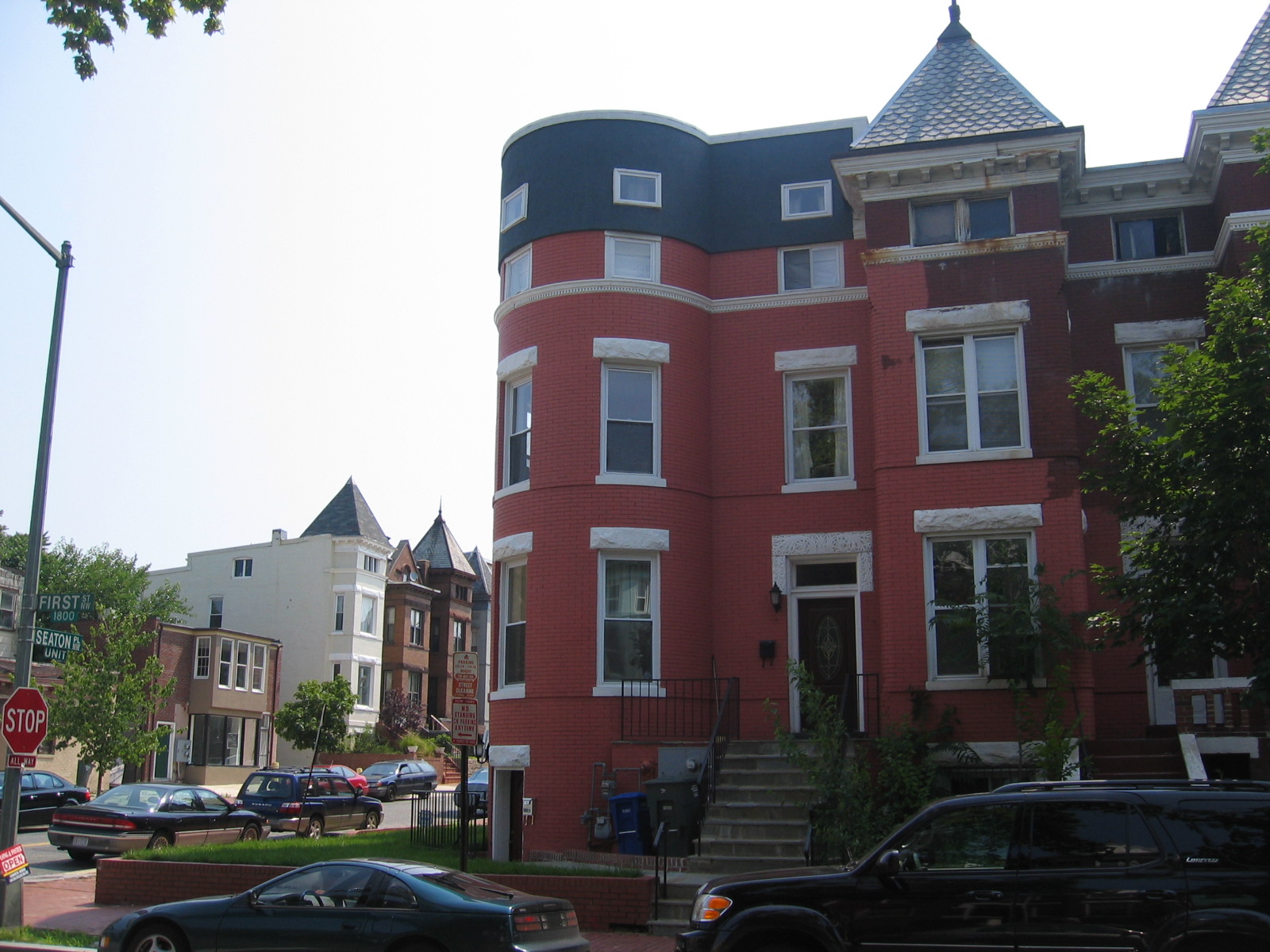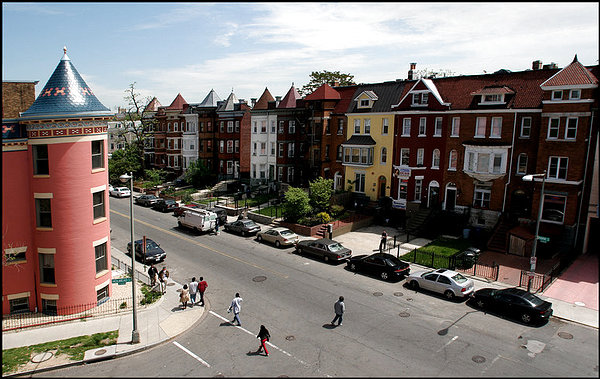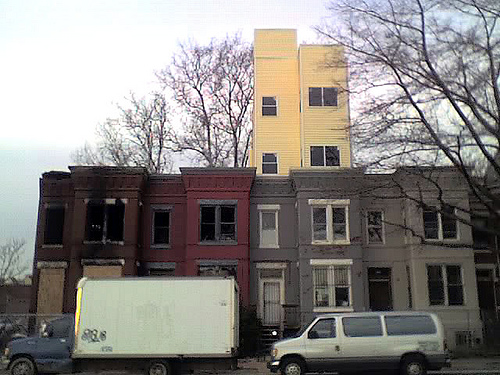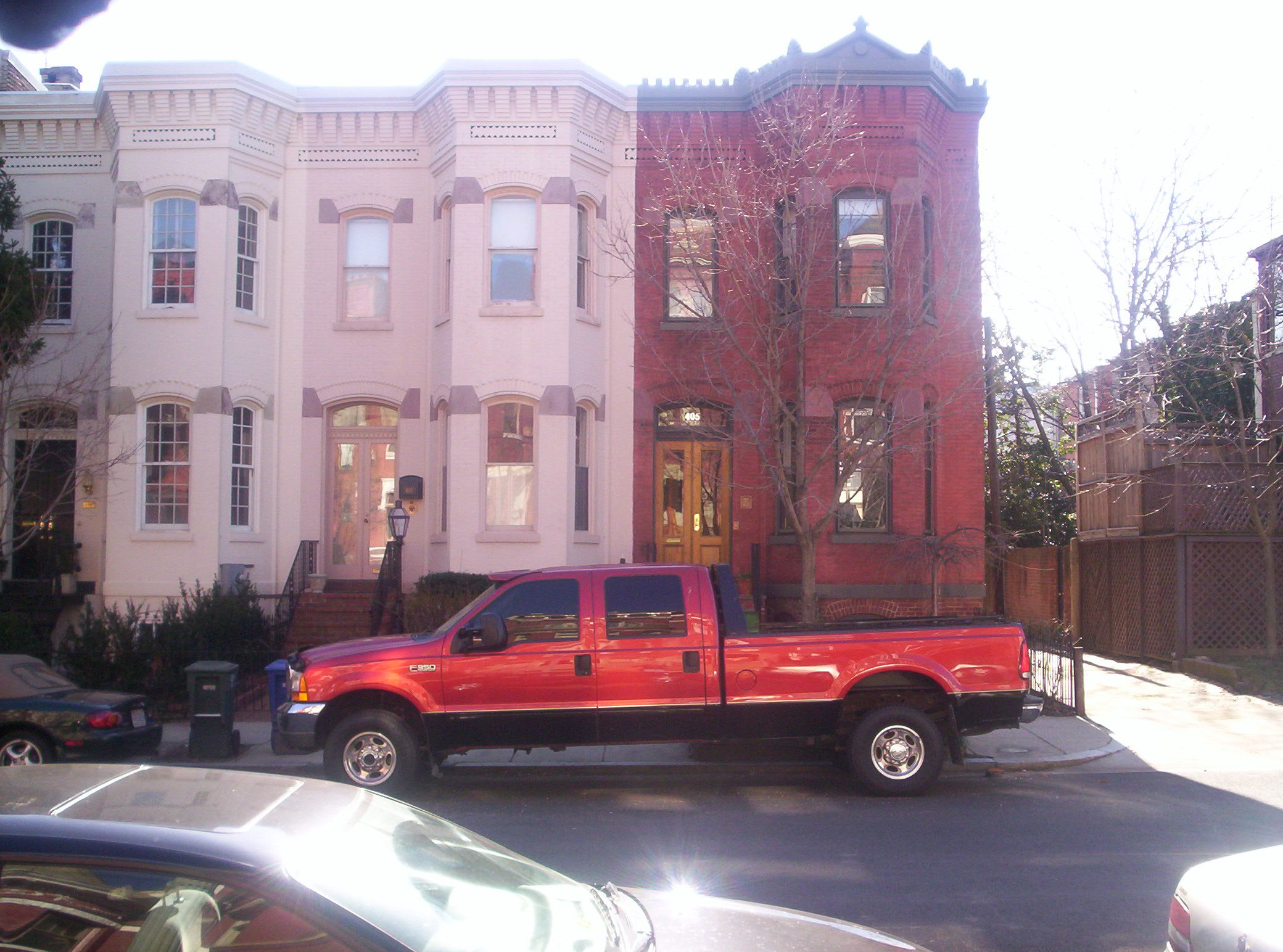Most of the "debates" on DC housing policy miss the obvious that a broad repricing is underway and widespread
There is a discussion on the historicwashington e-list about the R4 issue ("DC may impose limits on rowhouse heights," "A bad zoning plan would restrict expansion of housing in," editorial, Washington Post). R4 is the primary rowhouse residential zone.
There are proposed zoning changes that would put limits on upward expansions of houses, which are frequently referred to as popups, as well as the breaking up of rowhouses from single houses to flats (two units) or even more units.
 I have been concerned about "popups" for many years because they tend to be poorly designed and diminish the place value of neighborhoods.
I have been concerned about "popups" for many years because they tend to be poorly designed and diminish the place value of neighborhoods. For example, in some neighborhoods like Bloomingdale, height extensions can eliminate key architectural elements of houses that distinguish the neighborhood, such as the wrecked turret in the house pictured at left.
In fact, even the Post has written about it for awhile. I went around with the author of this piece ("New Rowhouse Rooflines Raising Eyebrows in D.C.") as he was preparing to write it back in 2007 (and in fact he wore me out, he wanted to keep going...).
From the list (edited and expanded):
The "affordable housing" argument about how keeping extant and historic buildings rather than demolishing them contributes to the maintenance of affordable housing is somewhat of a chimera as Washington is going through a broad repricing of housing, both for single family and for multiunit.
The repricing is significantly pushing prices upward, as more neighborhoods become attractive at the metropolitan scale.
This results from significantly increased demand chasing a limited supply and as a result, there are fewer and fewer opportunities to buy houses for less than $500,000 in most of the neighborhoods in the core of the city and/or those neighborhoods particularly well served by transit, especially in those neighborhoods marked by the presence of historic housing stock.
This is true for all of Northwest now, and a majority of near Northeast neighborhoods. The houses that are priced lower tend to have significant issues. But those pricing anomalies are short term and "corrected" over time through renovation and resale.
 DC's rowhouse building stock is one of the most distinguishing characteristics of the city's built environment. The photo at right (Washington Post) is of Columbia Heights, which is marked by particularly large houses that are easily converted to smaller units.
DC's rowhouse building stock is one of the most distinguishing characteristics of the city's built environment. The photo at right (Washington Post) is of Columbia Heights, which is marked by particularly large houses that are easily converted to smaller units.Housing production even in the intermediate term doesn't reduce or brake prices much, because it is still outpaced by demand being greater than supply.
However, when you add units, by breaking up larger rowhouses into smaller units, the accessibility to housing is being expanded and there is probably a barely discernible brake on pricing because supply is increased.
But they aren't affordable by any traditional definition, e.g., because of the repricing. These units serve "middle income" households, if there is a recognition that this is a much higher middle income (probably between $100,000 and $250,000 annual household income) than what has traditionally been thought of as "affordable" in Washington, DC.
That comes from the pricing shift and the resultant sorting of the households towards the upper end of household income stratas.
So it's fatuous to claim that keeping the housing stock fully the way it is in the Northwest quadrant of the city especially will retain "affordability," especially from the standpoint of access to housing by lower income segments of the population.
Note that the article in the Washington Post Saturday Real Estate section about Anacostia ("Anacostia's burgeoning potential catches the attention of home buyers") discussed how it is possible there to buy new houses, even new construction, for under $200,000. That's because the location and place values of the area are lower compared to the Northwest and Near Northeast sections of the city.
We are far from the days into the early 2000s, where someone could buy a house in the H St. neighborhood for under $100,000 or a studio apartment in the Cairo for under $95,000.
Also by way of comparison, yesterday I was in Baltimore for a walking tour as part of a conference, in the neighborhood anchored by Hollins Market, about 7 blocks from the Baltimore Hilton, Camden Yards, the Convention Center, the Camden MARC railroad station, and the University of Maryland medical campus, but across MLK Avenue, which is a ring road on the west of Downtown.
 This row of houses on Union Square in Baltimore dates to 1858. Flickr photo by Marc Szarkowski.
This row of houses on Union Square in Baltimore dates to 1858. Flickr photo by Marc Szarkowski.Besides the public market, the neighborhood also has a square, Union, with a great deal of potential.
While the houses on the square were quite attractive, we were told that prices are near $200,000.
In the greater neighborhood, one can find many large enough houses (messed up inside from the standpoint of preservation for sure and often what I refer to as "wacked") for $60,000 or less.
Now that's affordable...
The R4 debate is more complicated than either the proponents or the opponents are making it out to be. There are three elements.
1. Breaking up of large houses into smaller units.
2. Making smaller houses into larger houses by extending them upwards, usually in ways that diminish the architectural qualities of both the house and the row of houses on the block.
3. The legal differences between areas designated as historic and those that are not. In historic districts, popups are generally barred as part of the building regulation review process, while in undesignated areas the zoning disconnect allows the expansion--even if the house is virtually identical to a house in a designated neighborhood.
Large R4 houses get "broken" up into smaller units because the cost of the house as a single unit is significantly higher than most households can afford to either buy or maintain, and also results in "overhousing" or small households having far more space per capita than is preferred from a public policy standpoint.
 Near P and North Capitol Streets NW. Photographer unknown.
Near P and North Capitol Streets NW. Photographer unknown.Why people are opposed: design and place value. It is the expansion of houses, when done poorly and typically this is done poorly, which significantly diminishes the place value of neighborhoods, which is the primary point of contention for people like me.
... Even if simultaneously it makes housing if not more affordable, at least more accessible to more households, accommodates more residents, and contributing to the economic and social health of neighborhoods and the city.
 Why people are opposed: parking, parking, parking. Other opponents don't want more residents in their neighborhoods, primarily because of the competition for street parking, as the space in front of a rowhouse typically is only enough for one car, and households with multiple cars and houses with multiple units further stress the limited inventory of parking .
Why people are opposed: parking, parking, parking. Other opponents don't want more residents in their neighborhoods, primarily because of the competition for street parking, as the space in front of a rowhouse typically is only enough for one car, and households with multiple cars and houses with multiple units further stress the limited inventory of parking .I argue the solution to the diminishment of place value from R4 conversion is a combination of design review and much more specific guidance and requirements on how to do it, accompanied by some restrictions on conversion, based on property size and height.
Plus actively attracting to the city more people who don't prefer automobility. As more residents use cars less, this supports other elements of urban life like local retail, which further promotes sustainable mobility, further reducing car use, etc.
====
The issue gets further complicated because some people claim that they have bought houses, as owner occupied residences, because the house has the zoning authority to be expanded. They may or may not be truthful when they say they do this because it allows them to be able to afford to buy a house in a rising market.
 Photo of a DC rowhouse with a legal English basement apartment by Jeremy Crandell, on Flickr.
Photo of a DC rowhouse with a legal English basement apartment by Jeremy Crandell, on Flickr.So they oppose the move to restrict housing expansion as downzoning (Neighbors Against Down-Zoning).
Buying a house and converting a basement into a legally rentable "English basement" is a similar strategy. So could adding a carriage house (accessory dwelling unit). But neither approach requires significant changes to the existing built envelope of the property.
The problem, as I have been pointing out for years and years, comes from how zoning allows for taller houses than were typically constructed when the neighborhoods were first built.
One can argue that the disconnect in zoning between allowable height and prevailing height is an error, not an inherent property right, if maintenance of the architectural characteristics of the house and place are important to maintaining place value.
Be that as it may, the Office of Planning and other stakeholders, by not adequately explaining what is going on (and even if they did it might not make a difference) is making a more complicated and seemingly difficult to understand situation even more complicated.
And allowing the issue to fester for years and years doesn't make it easier to deal with when the agency is finally forced to deal with it.
Labels: building regulation, housing market, urban design/placemaking, urban planning, zoning



10 Comments:
we are seeing what my grandparents wnet thru just before WW2 and during WW2 here in DC- in other words- the city housing became so much in demand that many homes were broken up into smaller rooms for rent or small apartments- of course this was prior to condominums came into being [ which did not happen unitl the ealry 70's or so] and there was not much construction going on during WW2 except for temporary federal offices being put up and regular federal projects [ Pentagon] as it had been a depression era.I recall somehow that my family rented bunk beds to boarders and when my dad and his sister left home grandmom rented out their rooms quickly- she was a working mom as my grandpa got sick and had to go into a veterans hospital.I believe this pattern is being redone but in a new way. Similar kind of uptick in activity here and similar adaptations.
interesting that you reach back to that era as an example. That was how so many residents were accommodated.
When you look at old Census sheets, say from the 1920s or 1930s I haven't looked at the 1940 Census sheets, which are available now) this pattern is very clear. Many people lived in the houses that today now only have a couple residents.
It would be the main householders and their children, a relative or two of either the husband or the wife, and often boarders (probably with a relationship of some sort, through work, etc., to the adults in the household).
e.g. through the 1940s DC reached a population of almost 900,000, according to annual Census estimates. Although it started dropping after the war, and reached the official high of 802,500 in 1950.
This was higher than in 1940, but lower than many of the inter-year Census estimates.
The 1950 Comp Plan assumed that there would be 1 million residents in the city by the 1980s, although that scenario did not foresee the impact of integration and white flight.
We need a better understanding of why an area, or neighboorhood, goes downscale.
Clearly there are secular changes. Transit vs. highway vs. metro.
Or one in a lifetime ones such as forced integration.
We assume that house prices should go up, but in reality used house prices should go down.
as we have discussed in the PGC related posts, house prices aren't determined only by the age, style, and condition of "the house".
My other piece on the 5 components that shape housing prices is relevant. It doesn't discuss exogenous shocks though.
But too, despite houses being "used" central locations are usually going to be more valuable, hence the price of a house won't necessarily go down as it ages.
But wrt your other point, I think in _Understanding Neighborhood Change_ Rolf Goetze discusses how urban neighborhoods were abandoned because more than the necessary amount of housing was built in the suburbs, and people moved, and many properties became semi-permanently vacant.
The theories of the times were built on the idea that as people's economic circumstances improved, they always moved outward, but that they would be replaced by new categories (immigrants) ready to repeat the cycle.
That cycle is built on the belief in perennial growth and outward expansion.
But it was also a function of maybe a 70-100 year "exceptional" period of growth in the US that was atypical and not sustainable... when the US manufacturing system became globally preeminent.
Who would have thought in a 40 year period from 1945 that major US industries would decline precipitously in the face of globalization (e.g., automobiles, steel, textiles-apparel, furniture, etc.)?
It wasn't until the 1990s when US urban sociological theory began discussing how center city neighborhoods could/were re-attracting higher income segments of the market, attracted by locational and other benefits. (E.g., the Brooklyn Brownstoners, people living in historic neighborhoods circling Downtown DC, etc.).
at the conference, I had a long conversation with Alan Mallach (author of _Bringing Buildings Back_) and we were remonstrating about the failure of most people in the field to adequately distinguish between strong and weak markets at the metropolitan and sub-metropolitan scale.
More on that later.
with the city resurgent it now has a good chance to capitalize on the growth of the area it lost out on so much of in the 50's thru the 90's era when it contracted in population. If DC was more integrated into the region as it stands now- it would have likely more than a million people in the city but the city was just considered too dangerous and unwieldly to invest in. Hopefully the city government will adapt and lessen some of the more onerous reg problems that still hold us badly in DC. They are not open minded people, but as new folks move here and take over we might see more positive changes reflecting how the rest of the USA and other cities do things- in a better way.
well, the goal under the Gray Administration was to add as many as 200,000 more people (the current population is around 660,000, the goal is 850,000).
I don't see how we can add 100,000+ units to be able to add that amount of population. I could see potential for at least 10,000 ADUs (carriage houses) on alleys, but I would prioritize them in transit station catchment areas.
But you still need 90,000 more units.
Every time a project lops off a floor or two as part of satisfying citizen opposition, it becomes that much harder to achieve such a goal.
Plus, probably the creation of single family should be discouraged in the core, except for specific infill projects on a lot by lot basis, in favor of multiunit.
E.g., this should be a multiunit project.
http://capitolhillcorner.org/2015/01/07/plans-revealed-for-45-high-end-residential-units-near-capitol-hill-safeway/
not weirdly jammed in rowhouses.
In fact, I'll probably blog about it, but there is no way to change the project from happening.
It's about 1/4 mile walk to the Potomac Ave. Metro. I would use this site as a way to add multiunit housing with a reduced dependence on automobility.
It's an easy walk to the grocery, etc.
yes, I was thinking of your other post.
And yes, strong market/weak market.
Another aspect is a full range of rental properties. DC is highly unusual in that, although not fully developed.
(like anything that depreciates, it makes more sense to rent, but the variety of rental property stops at a certain point in most markets)
But most of what we've gone over is history, not prescription.
That said, one of the easiest ways to retain value is retain some "charm" and/or trees.
are you arguing that DC does have a wide and complete range of rental properties?
I tend to believe that our residential areas are pretty homogeneous and don't provide a wide variety of types.
E.g., in the old days, north of H St. and south of Florida Ave., the biggest apt. building had about 18 units. Most all the housing was rowhouses. Some small apt. buildings with 4 or fewer units. A set of large rowhouses that had been built from the beginning as apartments. Otherwise as many as 1700 rowhouses mostly set up as single family.
Post a Comment
<< Home